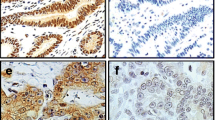Abstract
The c-Jun NH2–terminal kinase (JNK), which belongs to mitogen-activated protein kinase family, plays a major role in apoptosis in various cell types. JNK activation, however, also contributes to proliferation, survival, and tumorigenesis in some tumors, including gliomas. In this study, we used an immunohistochemical approach to examine the activation status of JNK of 226 gliomas in a high-density tissue microarray comprising all WHO codified WHO diffuse glioma subtypes and grades. The results were correlated with grade and EGFR expression status. Constitutively activated JNK (pJNK) was detected in 90.5%, 62.9% and 17.5% of WHO grade IV, III and II gliomas, respectively (p < 0.001). pJNK expression was not detected in the astrocytes or oligodendrocytes of any of 10 normal cerebral and cerebellar brain tissue samples. Among the 76 diffuse gliomas that exhibited EGFR expression, 63 (82.9%) were positive for pJNK. In contrast, only 50% (36/72) of the gliomas that were negative for EGFR were positive for pJNK (p < 0.0001). Overexpression of EGFR vIII in U87 cells or EGF treatment of U87-EGFR stable cells led to marked increase in JNK activation compared to parental U87 cells. Our data thus provide strong support for the hypothesis that JNK activation plays a role in the tumorigenesis and/or progression of diffuse gliomas, and suggests that EGFR is involved in constitutive JNK activation in diffuse gliomas. The ability to inhibit JNK activation might confer increased sensitivity to therapeutic modalities targeting this pathway.






Similar content being viewed by others
Abbreviations
- JNK:
-
c-Jun NH2-terminal kinase
- EGFR:
-
Epidermal growth factor receptor
- MAPK:
-
Mitogen-activated protein kinase
References
Cavenee WK, Furnari FB, Nagane M et al (2000) Diffusely infiltrating astrocytomas. In: Keilhues PCW (ed) Pathology & genetics: tumors of the nervous system. IARC Press, Lyon, pp 9–51
Burger PC, Vogel FS, Green SB et al (1985) Glioblastoma multiforme and anaplastic astrocytoma. Pathologic criteria and prognostic implications. Cancer 56:1106–1111
Daumas-Duport C, Scheithauer B, O’Fallon J et al (1988) Grading of astrocytomas. A simple and reproducible method. Cancer 62:2152–2165
Kim TS, Halliday AL, Hedley-Whyte ET et al (1991) Correlates of survival and the Daumas-Duport grading system for astrocytomas. J Neurosurg 74:27–37
Ohgaki H, Kleihues P (2005) Population-based studies on incidence, survival rates, and genetic alterations in astrocytic and oligodendroglial gliomas. J Neuropathol Exp Neurol 64:479–489
Wang SI, Puc J, Li J et al (1997) Somatic mutations of PTEN in glioblastoma multiforme. Cancer Res 57:4183–4186
Tohma Y, Gratas C, Biernat W et al (1998) PTEN (MMAC1) mutations are frequent in primary glioblastomas (de novo) but not in secondary glioblastomas. J Neuropathol Exp Neurol 57:684–689
Teng DH, Hu R, Lin H et al (1997) MMAC1/PTEN mutations in primary tumor specimens and tumor cell lines. Cancer Res 57:5221–5225
Steck PA, Lin H, Langford LA et al (1999) Functional and molecular analyses of 10q deletions in human gliomas. Genes Chromosomes Cancer 24:135–143
Ohgaki H (2005) Genetic pathways to glioblastomas. Neuropathology 25:1–7
Antonyak MA, Kenyon LC, Godwin AK et al (2002) Elevated JNK activation contributes to the pathogenesis of human brain tumors. Oncogene 21:5038–5046
Cui J, Han SY, Wang C et al (2006) c-Jun NH(2)-terminal kinase 2alpha2 promotes the tumorigenicity of human glioblastoma cells. Cancer Res 66:10024–10031
Kennedy NJ, Davis RJ (2003) Role of JNK in tumor development. Cell Cycle 2:199–201
Whitmarsh AJ, Davis RJ (1996) Transcription factor AP-1 regulation by mitogen-activated protein kinase signal transduction pathways. J Mol Med 74:589–607
Kononen J, Bubendorf L, Kallioniemi A et al (1998) Tissue microarrays for high-throughput molecular profiling of tumor specimens. Nat Med 4:844–847
Wang H, Wang H, Zhang W et al (2002) Tissue microarrays: applications in neuropathology research, diagnosis, and education. Brain Pathol 12:95–107
Wang H, Wang H, Zhang W et al (2004) Analysis of the activation status of Akt, NFkappaB, and Stat3 in human diffuse gliomas. Lab Invest 84:941–951
Tsuiki H, Tnani M, Okamoto I et al (2003) Constitutively active forms of c-Jun NH2-terminal kinase are expressed in primary glial tumors. Cancer Res 63:250–255
Butterfield L, Storey B, Maas L et al (1997) c-Jun NH2-terminal kinase regulation of the apoptotic response of small cell lung cancer cells to ultraviolet radiation. J Biol Chem 272:10110–10116
Garay M, Gaarde W, Monia BP et al (2000) Inhibition of hypoxia/reoxygenation-induced apoptosis by an antisense oligonucleotide targeted to JNK1 in human kidney cells. Biochem Pharmacol 59:1033–1043
Hreniuk D, Garay M, Gaarde W et al (2001) Inhibition of c-Jun N-terminal kinase 1, but not c-Jun N-terminal kinase 2, suppresses apoptosis induced by ischemia/reoxygenation in rat cardiac myocytes. Mol Pharmacol 59:867–874
Ip YT, Davis RJ (1998) Signal transduction by the c-Jun N-terminal kinase (JNK)–from inflammation to development. Curr Opin Cell Biol 10:205–219
Kapoor GS, O’Rourke DM (2003) Mitogenic signaling cascades in glial tumors. Neurosurgery 52:1425–1434
Preusser M, Haberler C, Hainfellner JA (2006) Malignant glioma: neuropathology and neurobiology. Wien Med Wochenschr 156:332–337
Antonyak MA, Moscatello DK, Wong AJ (1998) Constitutive activation of c-Jun N-terminal kinase by a mutant epidermal growth factor receptor. J Biol Chem 273:2817–2822
Author information
Authors and Affiliations
Corresponding author
Additional information
Jian Yi Li and Hua Wang contributed equally to this work.
Rights and permissions
About this article
Cite this article
Li, J.Y., Wang, H., May, S. et al. Constitutive activation of c-Jun N-terminal kinase correlates with histologic grade and EGFR expression in diffuse gliomas. J Neurooncol 88, 11–17 (2008). https://doi.org/10.1007/s11060-008-9529-1
Received:
Accepted:
Published:
Issue Date:
DOI: https://doi.org/10.1007/s11060-008-9529-1




